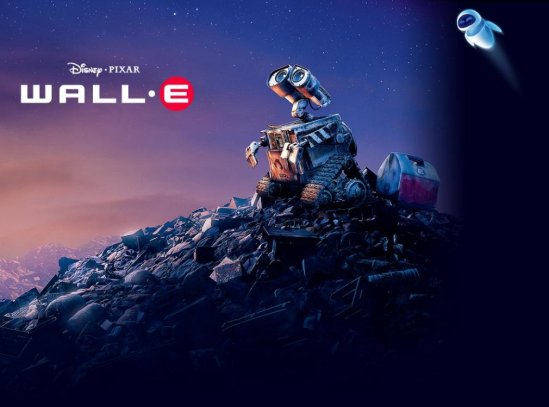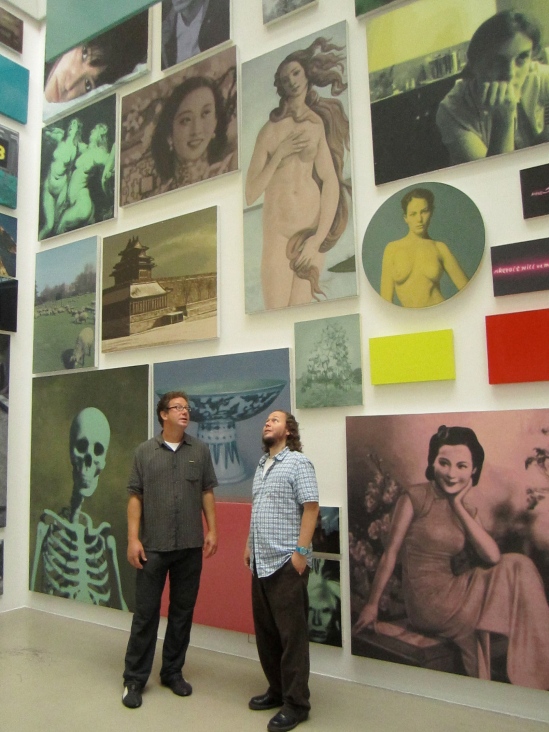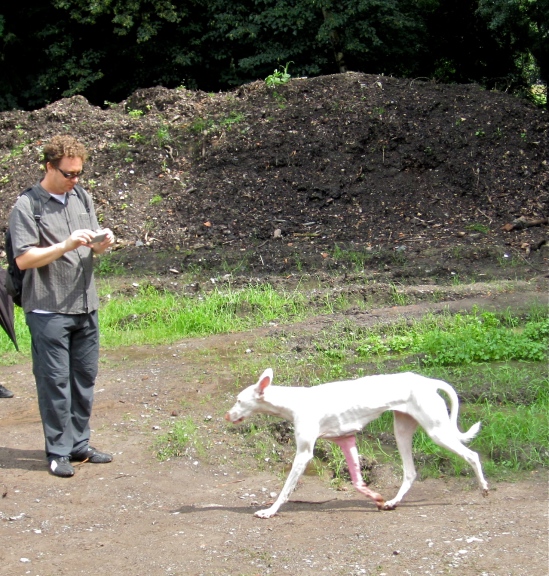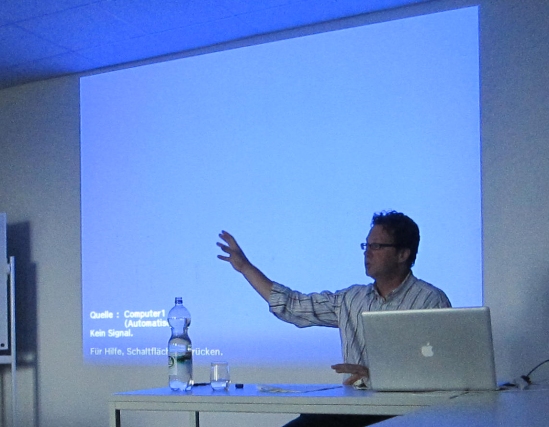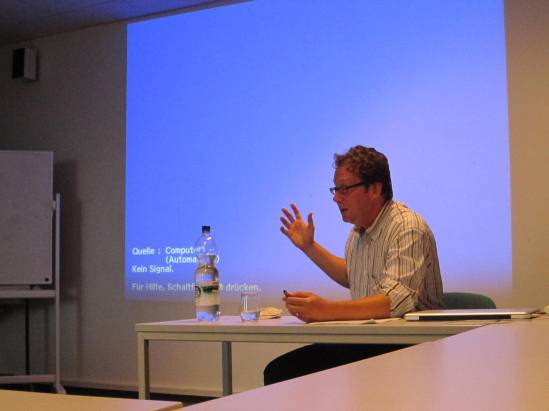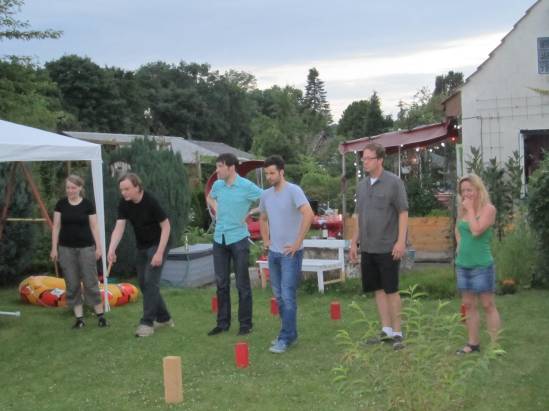Tonight was the last night of our film series, “Chaos Cinema?” Here are the notes for my presentation on WALL-E:
WALL-E vs. Chaos (Cinema)
Shane Denson, 19 July 2012
Not long ago, I argued for a reconceptualization of recent cinema in terms of the rise of what I called “discorrelated images”—images that announce a certain amount of autonomy from human perceptual consciousness and that therefore resist being yoked or, to speak in the terms of the speculative realists, “correlated” completely to the subject of classical phenomenology.
My argument, which took Michael Bay’s Transformers (2007) as its central case study, was directed against Matthias Stork’s intriguing but ultimately limited conception of “chaos cinema,” which tends to see the frenetic filmmaking of the type that Bay is known for as basically sloppy in its disregard for the rules of classical continuity editing. Following the lead of Steven Shaviro, with his conception of “post-continuity” as an aspect of a broader regime of “post-cinematic affect,” I argued that the breaks with continuity singled out by Stork as the hallmark of chaos cinema are in fact merely symptomatic of a much larger shift in our media culture—signs, in fact, of an uncertain transition that we are still undergoing and that concerns a major overhaul of the place of the human in the cosmos, of our affective interface with material reality, or of our sensorium as a historically conditioned aspect of our embodied contact with the environment.
Concretely, I argued that the “operational aesthetic” expressed or elicited in scenes of Transformers’ transformations demonstrate that there’s more at stake than a simple break with continuity; for these images need not involve any violation of the 180° rule, the 30° rule, or any other convention regulating the editing practices of classical Hollywood film. Clearly, the chase scenes highlighted by Stork do involve such violations, but it seems somewhat arbitrary to single out such phenomena as definitive of a style or even an entire era of cinema, while the transformation scenes are clearly the centerpiece visual spectacles of the Transformers films and must therefore be accorded a central position in the aesthetic appeal of these particular films (if not in the aesthetic appeal of post-millennial popular cinema as a whole).
Taken together, a very different image emerges: we find then not just continuity violations but a more general discorrelation of images from the spatial and temporal parameters of “normal” human subjectivity. The transformation scenes, with their incredibly detailed displays of minutely articulated and perfectly synchronized processes, embody a sort of information overload: they are too much for us to take in at once, too fast for our eyes or even our perceptual imaginations. This fact is of course related to the digital technologies that are responsible for their production; computational processing divorces images in their materiality from the hitherto reigning analogies between eye and camera. More centrally still, these images are severed from the historical correlation between the perceptual subject of vision and the medial apparatuses that cater to (and condition) that subjectivity. The result of discorrelation must indeed seem like “chaos,” because it signals a certain superfluousness of consciousness, a displacement of the constituted subject and of the properly human—a displacement that we feel today in the face of semi-autonomous finance markets and, crucially, the chaos of environmental change and catastrophe as well.
WALL-E, I want to suggest, displays an acute awareness of these displacements. Its very medium, digital animation, is implicated materially in the discorrelation of human perception, as it is in this medium that, following arguments made by Mark Hansen, the image ceases to be an object (of either a perceiving subject or of an apparatic analog medium) and instead becomes fully processual (both with respect to the microtemporal processes of its technical, i.e. computational, generation, and with respect to its microtemporal neural processing, which in bypassing conscious awareness must be regarded as a completely affective form of sensory reception). Digital animation is therefore the pinnacle of what, in an effort to further specify the conditions of contemporary cinema and to move beyond the simplifying label of “chaos” cinema, I would like to call “hyper-informatic cinema.”
This label is meant to highlight two related aspects of contemporary cinema, or of an important tendency in recent film: 1) Hyper-informatic cinema is based on a profusion of informatic (i.e. digital) technologies, both diegetic and non-diegetic—an overabundance of computers in the production of contemporary films (which rely heavily on CGI and digital compositing techniques), and of computational agencies in the films so produced (which feature robots, transformers, and cybernetically enhanced aliens, but also humans seeking to master or simply navigate the computational environments in which we already live today). 2) Such films are hyper-informatic in the sense I referenced above: they exploit scenarios of information overload, either as spectacle or as (at once narrative and affective) dilemma. In these scenarios, there is simply too much information, thrown at us far too fast for us to process it in full. The “intensification” of continuity that Bordwell speaks of can in large measure be traced back to this aspect of hyper-informatic speed, and the breakdowns that Stork labels “chaos” result from the mismatch between computational microtemporalities and the macrotemporality of the consciousnesses they challenge.
But rather than exacerbating the perceptual mismatch of digital discorrelation, WALL-E instead effects a reduction of informational content, without thereby denying its self-awareness of the fascinations of its informatic medium. There is a lack of talk, and a lack of speed, but there is no lack of visual spectacle and of inter-medial comparisons that highlight (and historicize) the film’s own digital substrate: thus, WALL-E is a fan of the film Hello, Dolly!, a relic of a bygone (human) era which he consumes through an assemblage of antiquated technologies, including cassette recorders, iPods, and magnifying glasses. WALL-E marks, indeed embodies, a discorrelation of the image from human perception, but the film need not flaunt it in the style of Michael Bay. Instead, WALL-E would seem to offer a measured response to it, one that places it in close connection to the “chaos” that characterizes not only our cinema at present but our estrangement from an environment marked by post-industrial carelessness, pollution, and e-waste. Reading the hopeful story of ecological recovery in medially self-reflexive terms, perhaps we could say that WALL-E’s quest to clean up the earth is less a battle to restore the human to a position of centrality, autonomy, and mastery over nature, as instead a far more limited, but also far less utopian, struggle to accept discorrelation and to effect a cinematic recalibration: an attunement of sensory capacities and images qua informatic processes.
